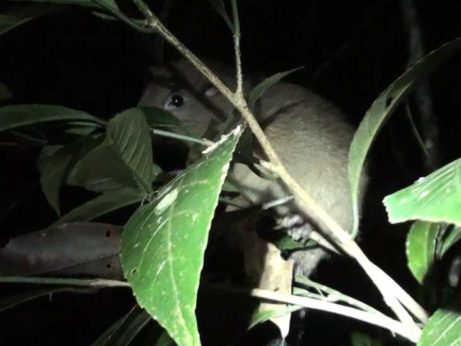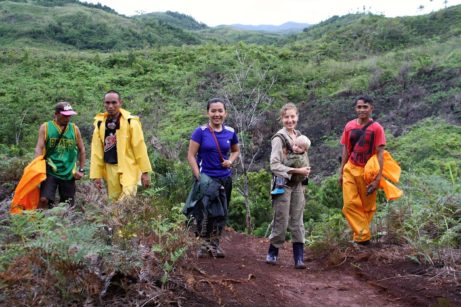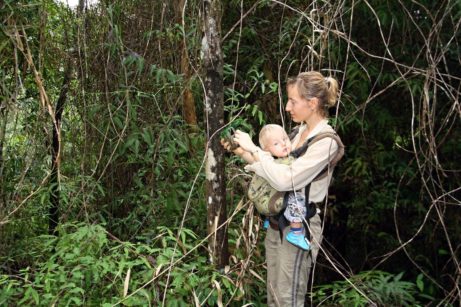Endangered species
Philippine tarsier
(Tarsius syrichta)
This interesting animal is often described as the smallest monkey of the world. But it is neither monkey nor the smallest.
Morphology
With their body size they really belong to smallest primates of the world (average weight is 110 – 140 gram) 2,4. They got their English, Latin and also Czech name according to elongated tarsus. Elongated and clubbed fingers serve for better adhesion to substrate. The whole body except the tail is covered with very soft fur. They have extremely big head in comparisons with body. Their enormously huge eyes are fixed in the skull and weight together more than brain of this animals. Such big eyes are necessary for their nocturnal life. Perfect vision is extremely important for them. In contrast to most of nocturnal primates tarsiers lack tapeum lucidum (light reflecting area in the eye). A special adaptation of the back bone allows rotating head up to 180 degrees without moving the body.
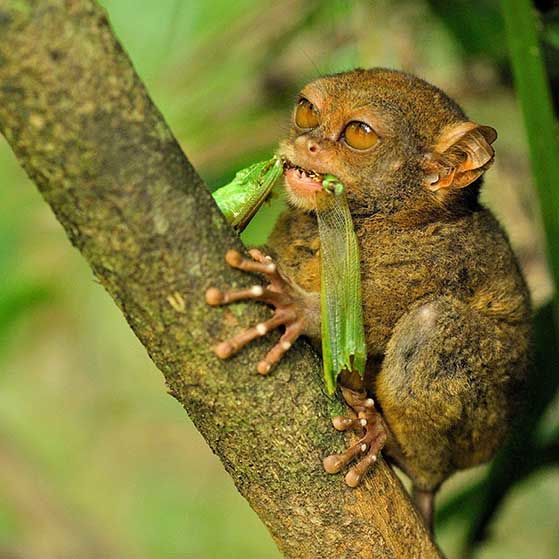
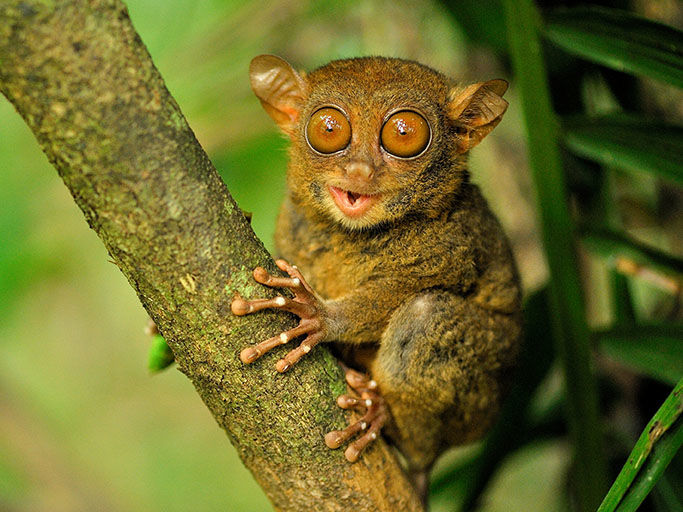
Ecology and behaviour
Tarsiers are nocturnal insectivorous primates. They are the only strictly carnivorous primates. Tarsiers prey mainly on insects, but may feed also on spiders, crustaceans, small vertebrates, e.g. lizards. To the main predators except humans belong feral cats, civets, raptors, snakes or monitor lizards as recorded during our study5.
Tarsiers are active from dusk to dawn. During day they rest covered in the trees 1-2 m from the ground. Tarsiers are arboreal clingers and leapers. Social system of tarsier is quite variable from monogamous pairs to family group with alloparenting. Because of nocturnal life style the olfactory and acoustic communication are the most important. Tarsiers scent mark their home-ranges regularly and regularly vocalize at dusk and dawn. In our two years study we have described the acoustic repertoire of the Philippine tarsier 6. Tarsiers live in various habitat types – primary and secondary forest, mangroves include tropical rainforest with dense vegetation and trees that offer it protection like tall grasses, bushes and bamboo shoots. They are lacking in areas with high human density and intense agriculture 2,4, so their occurrence becomes rarer.
Systematics
Tarsiers form their own lineage between prosimians and monkeys. To date several species living in Southeast Asia – Sulawesi, Sundaes a Philippines have been described.
Only one species Tarsius syrichta is found in the Philippines. Three subspecies of Tarsius syrichtahave been described. All these subspecies are found on islands that belonged to former large Pleistocene island of Greater Mindanao. Tarsius syrichta syrichta lives on Samar and Leyte, Tarsius syrichta carbonarius on Mindanao, Tarsius syrichta fraterculus on Bohol. Other populations were found on Dinagat, Siargo and Basilan (Brandon-Jones et al. 2004) and they could be regarded as different subspecies1. A recent study discovered four genetically distinct lineages that differ from the previously recognized subspecies7.
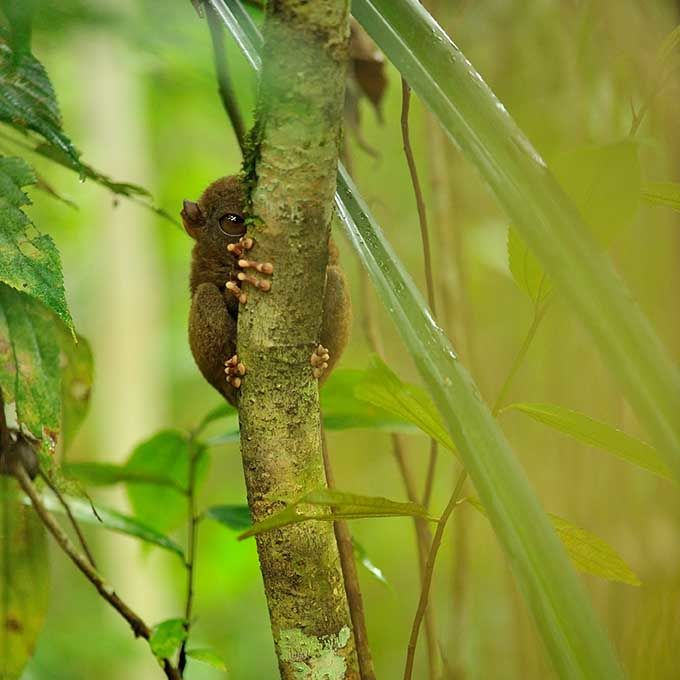
Population status and conservation
According to the IUCN Red book 3 this species has been transferred from “Data Deficient” category to the „Near Threatened“ category. Population of the Philippine tarsier is decreasing. Habitat loss and illegal pet trade are the main threats. After the Presidential Proclamation from 1997 the Philippine tarsier (Tarsius syrichta) is specially protected faunal species of the Philippines. His future depends on conservation activities and education of local people. Detailed research that will help to gain lacking information about this species is necessary.
Tarsiers and the Philippines remaining biodiversity and the ecosystems are under tremendous threats. Logging and mining have destroyed most of the forests. Except of the degradation of their habitat tarsiers are threatened directly by humans. Tarsiers are killed as pests while hunting for insects on the field and they are hunted for illegal wildlife pet trade or used as tourist attractions. Until recently, the animals were kept in small cages with unsuitable conditions, especially in Loboc, one of the greatest Bohol’s tourist destinations. Private holders offered the tarsiers show in order to attract visitors for boat trip. Stressed animals were kept in absolutely unsuitable conditions, in small cages, visitors are allowed to feed, touch and hold them – all during the day, which is very stressful for nocturnal animals. In these circumstances tarsiers don not survive more than few weeks or months. As tourism increased, a rising number of tarsiers were taken from the wild. Thanks to effort of the Tarsius project and a huge support of the ambassador of the Czech Republic Josef Rychtar all the unsuitable centres were closed and tarsiers transferred to a big and naturally planted enclosure. We have informed you about this success on our website.
There is another centre on Bohol Island run by the Philippine tarsier foundation, Inc. in Corella, which offers quite good conditions to both tarsiers and visitors. Recently tarsier sanctuary of total area 174 ha was established in its surrounding. However, the foundation does not keep any records about breeding or any other information that could help to start a successful tarsier population in captivity.
Therefore, after years spent in the field we have decided to build a conservation centre for tarsiers as a part of the Tarsius project. More in the Project section>>.

References
1 Brandon-Jones, D., Eudey, A.A., Geissmann, T., Groves, C.P., Melnick, D.J., Morales, J.C., Shekelle, M. & Stewart, C.B. 2004. Asian primate classification. International Journal of Primatology 25, 97-164
2 Dagosto, M., Gebo, D.L. & Dolino, C. 2001. Positional behavior and social organization of the Philippine tarsier (Tarsius syrichta). Primates 42, 233-243.
3 Arboleda, I. 2008. Tarsius syrichta. In: IUCN 2008. 2008 IUCN Red List of Threatened Species.
4 Neri-Arboleda, I., Stott, P. & Arboleda, N.P. 2002. Home ranges, spatial movements and habitat associations of the Philippine tarsier (Tarsius syrichta) in Corella, Bohol. Journal of Zoology 257, 387-402.
5 Řeháková-Petrů M., Peške L., Daněk T. (2012) Predation on a wild Philippine tarsier (Tarsius syrichta), Acta Ethologica, DOI: 10.1007/s10211-011-0096-7
6 Řeháková-Petrů, M., Policht, R., Peške L. (2012) Acoustic repertoire of the Philippine tarsier (Tarsius syrichta) and individual variation of long distance calls, International Journal of Zoology, in press
7 Brown, R. M., Weghorst, J. A., Olson, K. V., Duya, M. R. M., Barley, A. J., Duya, M. V., et al. (2014). Conservation genetics of the Philippine tarsier: Cryptic genetic variation restructures conservation priorities for an Island Archipelago primate. PLoS ONE, 9
Dinagat bushy-tailed cloud rat
A rediscovery of Dinagat bushy-tailed cloud rat helped starting conservation activities on Dinagat Island, Philippines.
A Dinagat bushy-tailed cloud rat, belonging to the biggest rodents of the world, is endemic to only one tiny island of the world – Dinagat Island, Philippines. This species was captured only once in the history, in 1975. It belongs to critically endangered species, and was even feared to be extinct until early 2012, when it was observed and video recorded by a scientific couple from Czech Republic. This success help to start conservation activities focused on this and other endangered species. In December 2016 czech-filipino expedition focused on mapping and establishing of protected areas on Dinagat Island where no protected areas exist so far. The cloud rat was recorded again after almost five years as well as another rare species, Dinagat Gymnure or Philippine tarsier.
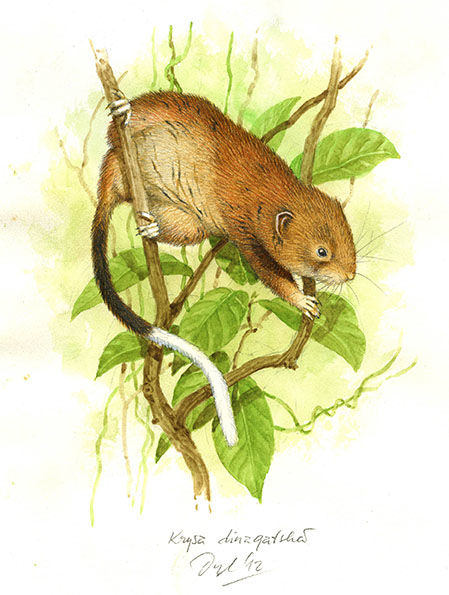
The Environment Secretary Gina Lopez recently announced closing of mining operations because of mining in watershed areas, which is a burning issue especially on Dinagat Island.
Cloud rats are the biggest (body size 30-70 cm) and most spectacular murids of the world, endemic only to a few Philippine Islands. They are nocturnal arboreal animals. The Dinagat bushy-tailed cloud rat (Crateromys australis) is the least known among them. So far, it was known only from one specimen captured in 1975. Since then number of scientific expeditions have searched for this elusive species, but with no success. It changed in early 2012 when it was rediscovered by a Czech zoologist Milada Řeháková and her husband. The lost species was scientifically confirmed and this huge hairy grey-brown rat with hairy and conspicuously black-white tail was video documented for the first time ever.
This species is endemic to a small island of the Philippines, where mining and logging posses a serious threat to all wildlife, including the critically endangered Dinagat bushy-tailed cloud rat. Therefore it is a huge success that this rediscovery help to raise conservation activities and start a project focusing on mapping and establishing of 1000ha of protected areas on Dinagat Island. In November-December 2016 czech-filipino expedition succeeded to document the cloud rat again after almost five years, as well as other species including tarsier. Another huge success is the finding of Dinagat Gymnure, related to hedgehogs, which is for the first time when this elusive species has been photographed and videorecorded in the wild.
“I am very happy that our Philippine partners came up with the idea of establishing of protected areas on Dinagat Island and that I can be part of it. Dinagat bushy-tailed cloud rat is a unique species that is not found anywhere else on the planet and deserves protection”, emphasizes Dr. Milada Řeháková.

